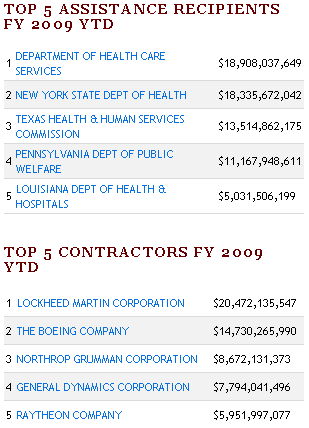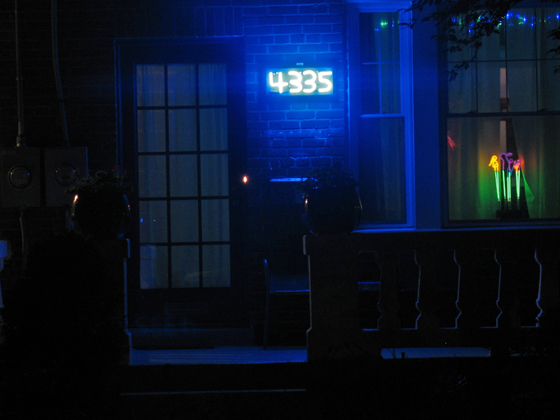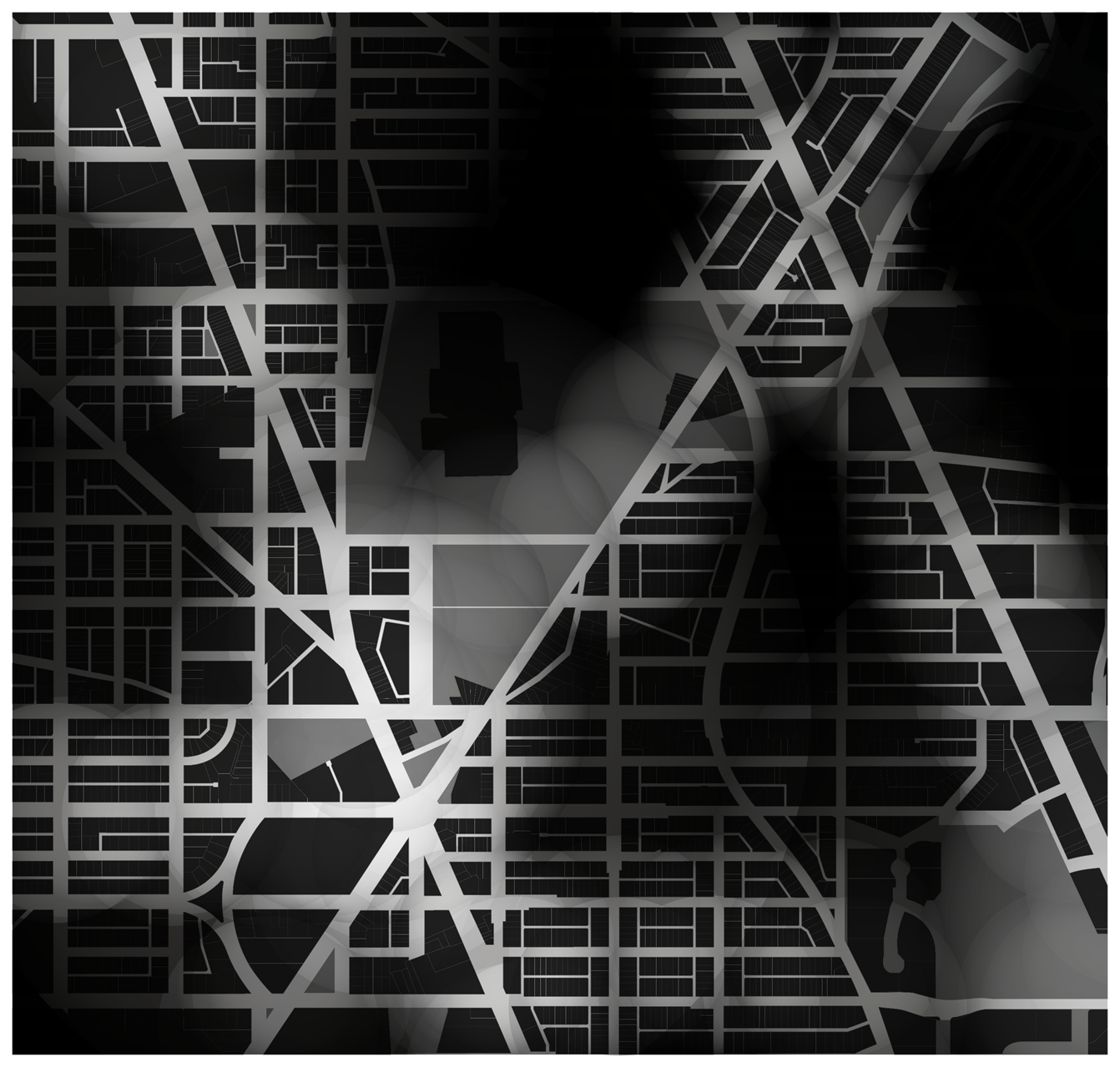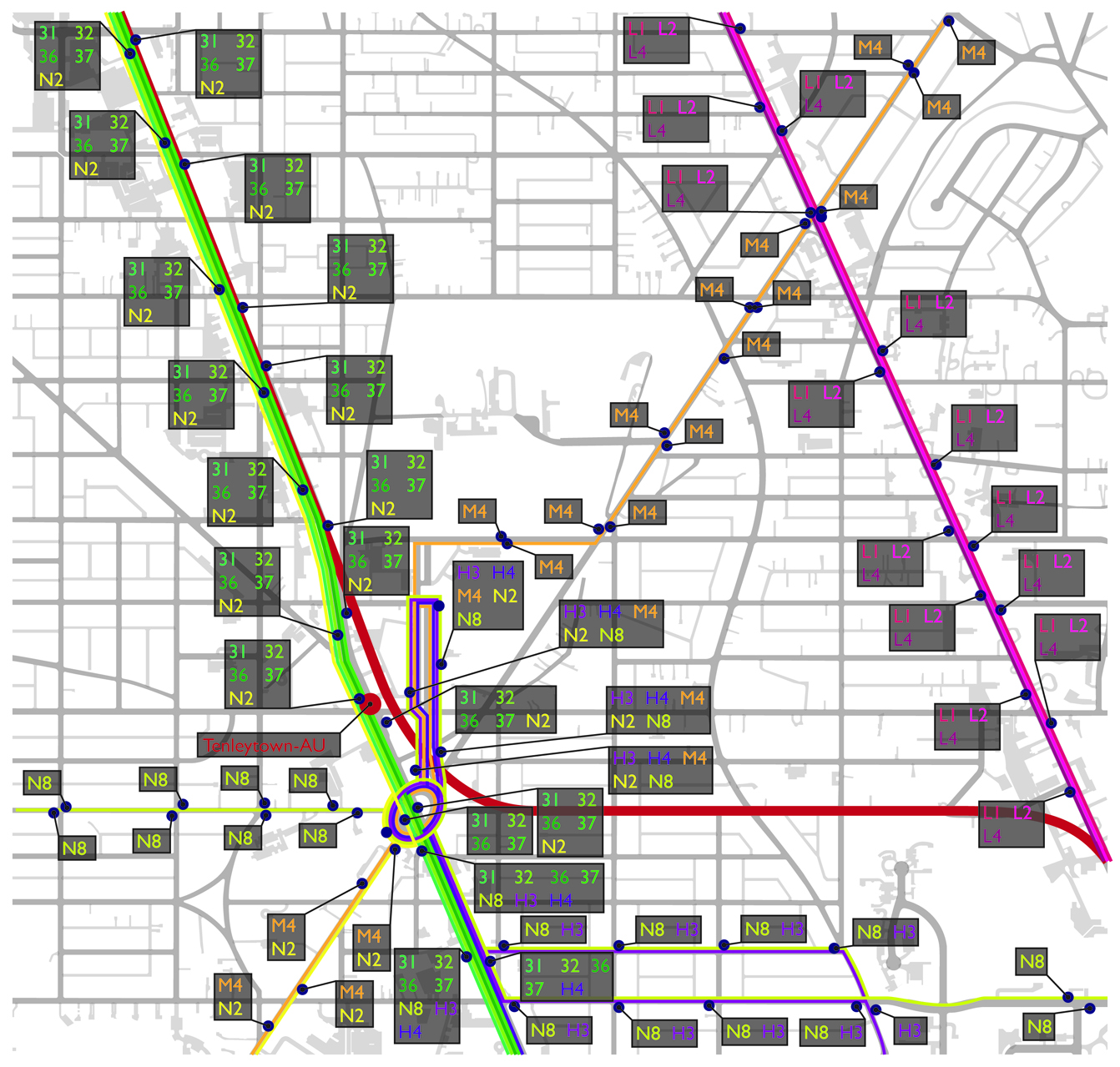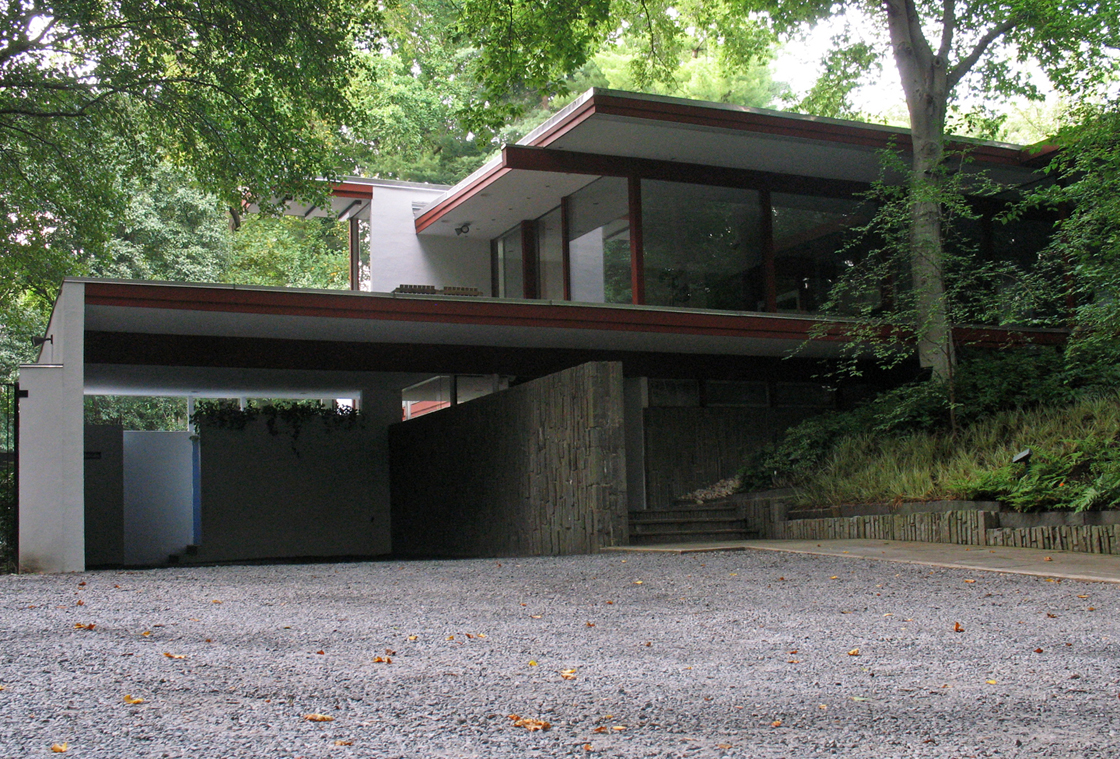Neon
I think it works pretty well (somehow). Weird. Two more under the fold.
Reno Park Update 090804B: Transit Fade
Ok, so for the second set of transportation analysis, I’ve compared transit accessibility to lot areas. Even without buildings, it’s possible to get a sense of the transit-accessible public space here. Areas that are lighter have more transit options. Again, Tenleytown is a hub of activity, where the blocks around the circle and the Metro stop are major transfer points that get a lot of street traffic.
So, Chevy Chase isn’t really the most transit-accessible place in the world. Even if I had used a 1/4 mile radius for buses, there would have been a dark spot there. Also, note that the commercial strip between Fessenden and Ellicott streets is in the 1/2 mile radius overlap between Tenleytown and Friendship Heights, which may contribute to its success, in spite of being somewhat isolated by the hill to the south. Read on for a breakdown of plans.
Reno Park Update 090804A: Transit Radii
I’m still working on the buildings and pedestrian maps, but I took a break to chart out the public transportation resources. I’ve included all public transportation resources, but not AU shuttles or the W45/47. Those aren’t accessible to 90% of potential park users, so I’m not interested. So, to start, here’s a route map. Clearly, it gets kind of insane around Tenleytown.
Note: These drawings are in an Adobe CMYK color space, so may look wacky on some computers.
So that’s a good beginning. These are obvious facts. Under the fold is an analysis of the walksheds for each stop, station, and line.
North of Tilden: Developments in development

Tenleytown: The Ward 3 Aquatic Center, or the Wilson Pool, as everyone will call it, will have a formal opening, complete with Fenty, on Monday, August Third, at 10:30 AM. The Hughes group have put together an inoffensive structure, but it supposedly boasts the capability for daylighting, natural ventilation, and water-loss mitigation, earning it a LEED Silver certification. The pool has been desperately needed since the shoddily built predecessor started falling apart at a more rapid rate in 2003.
Hawthorne, Palisades, Green Acres?: Opposition to sidewalks continues in the hinterlands of DC, where DDOT has been adding the badly needed infrastructure. This time, it’s over in Palisades, on Chain Bridge Road and University Terrace. Roger Lewis and Ward 3 Council member Mary Cheh went on the Kojo Nnamdi show. Lewis shared some interesting history, but it was Cheh that laid down the law, insisting on sidewalks, but also demanding DDOT involve community members more. The two both agreed that the rational need for a network of sidewalks was a no-brainer. Callers disagreed, for some reason, mostly that “they’re not used” and they’ll “ruin the character of the neighborhood.” The panelists offered reasonable responses to the entitled views of opponents.
However, aside from the Cheh-Lewis lovefest, the two missed some important points, such as the dubious wisdom of low-density, limited-network streets in the middle of the city. One of the callers declared that residing in the area seemed like living in the country, but near the city. That’s just swell, but neither addressed whether having such low density a mere 4 miles from the center of town was a good idea. Also, Nnamdi and Lewis both guiltily admitted to driving on University Terrace routinely. Listen to the conversation, it’s worth some down time.
Soapstone Valley gets blogged!
Forest Hills’ Brown House
Upper Northwest has a reputation for having bland architecture, with the exception of pre-Depression Chevy Chase. But that’s proving itself to be a not completely true perception. Down at the eastern end of Audubon Terrace in Forest Hills there’s a real treasure of modern architecture, almost completely buried the trees of Soapstone Valley. Although it’s been a house I’ve admired since a stopping a run in the valley back in high school, Modern Capital clued me in to the house’s authorship by the definitive SoCal architect, Richard Neutra.
The residence, known as the Brown House, was built in 1968, only two years before the architect’s death. It is the only example of that architect’s work in DC, and one of only a few on the East Coast. More photos under the fold.
Last Week of Reno
Monday, July 27th
North America, Stoney Lonesome, Pree
Thursday, July 30th – Last show of the season!
See, structure is a building system
North of Tilden: Old wounds

I. The city has declared that they will begin construction of the new Freelon-Group-designed library in September. However, out on the Tenleytown Listserv, discussion flared up when it became clear that the department of economic development was asking the architect to add structural columns that could support multistory residential. This practice is not uncommon, but it would be a wasteful expenditure if the Tenleytown Historical Society succeeds in landmarking the school, and adding to the structure becomes more difficult. Both properties sit on the same lot.
II. The HPRB has agreed to review a preservation application for the 1925 elementary school. Built by the city architect, Albert Harris, it’s a decent example of the stripped-down Beaux-arts Georgian style he developed for the rapid expansion of public facilities in the early 20th Century. Although it was the first of all the schools built in the area, I don’t see how the 84-year-old school merits perpetual legal protection, at least not at this point. Especially considering that the building is not in any danger of demolition or permanent alteration. Moreover, landmarking could seriously delay the much-needed renovation of the aging school needlessly.
III. The department of education is proceeding, however, with the development. They’ve hired Devrouax + Purnell to design a wing to the west of the current building. Part of the planning framework requires that DP respect the historical structures of the area. I have no doubt that they will. Their work in DC has been humane and sensitive, while also adding innovating modern elements. Freelon and DP’s buildings will be coups for the architecturally stagnated area, so it’s in the neighborhood’s interest to support their work.
IV: On the site of the former Oakcrest School at 4101 Yuma Street, a new religious center for women and girls will be opening this fall. The Yuma Study Center, a vaguely defined but Opus-Dei-affiliated religious institution will itself be renovating and expanding the old Bon Secours covenant. The current structure is dilapidated, so renovation will be welcome, once I can figure out exactly what the institution does.
Van Ness: This past weekend saw the second-ever farmers’ market on the plaza in front of UDC. The market is a twofer fer the residents of condograd across the street, putting the large plaza to use and getting farm-fresh goods onto a public street.
Hawthorne: The Post covers the ongoing slapfest in the very northern neighborhood of Hawthorne, a small collection of 1950s houses that was built in the fashion of the times: without sidewalks. DC has been improving and adding sidewalks throughout the city, improving pedestrian safety and encouraging walking, however, some residents of the area northeast of Utah Avenue won’t have any of that filthy urban nonsense. They moved there because they wanted to be in DC without being in the city.
What, they stayed in DC for the schools? Or for the lack of voting rights?
The arguments against sidewalks sort of tumble out of opponent’s mouths, with all kinds of illogic. This is like country in the city, yes, and a ranch house makes your .2 acre lot a ranch. Nobody walks around here, uh, ever wonder why? We need curbs, not sidewalks, so pedestrians can’t get out of the way of cars? Lastly, the venerable, but that’s the way it’s always been! makes its appearance, proving opponents to be examples of a certain five-letter acronym. You can hear how literally incoherent their arguments are in this video.
On the other hand, there are almost as many proponents, since many residents do see the public obligation to make the streets safe and accessible for all modes of traffic. It’s heartening to see proponents of reasonable growth out and advocating their position. There’s not much of a worry that Hawthorne will become infected with the dread contagion of urbanism, since it’s pretty far from any sort of rapid transit and unsuitable for larger growth. It’s always going to be a side neighborhood, one whose character will not be negatively altered by allowing people to walk comfortably around their neighborhood.
